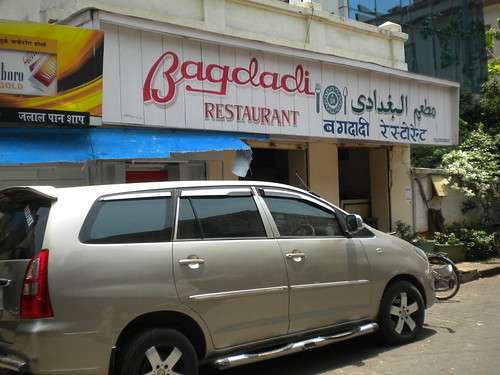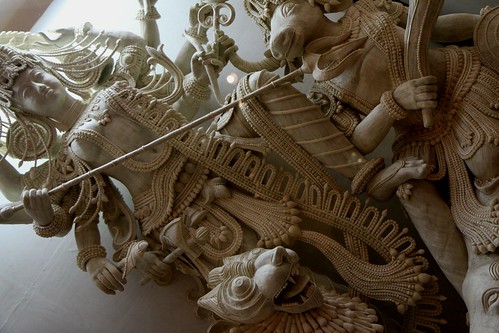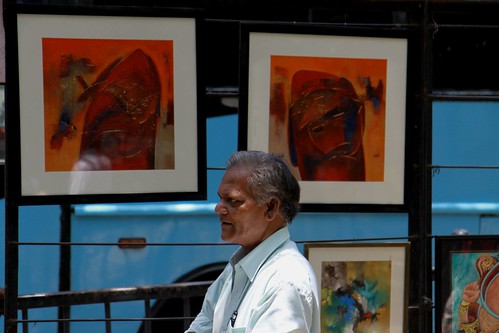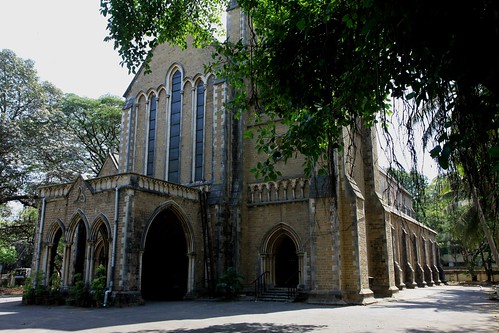Now that we are back in Bombay and will be here for at least a couple of weeks, Madhu and I have decided to formally ‘tour’ our favorite city as well. The only problem is location. We are shuttling between Thane (my parents’ place) and Kandivli (Madhu’s parents’ place), both of which are not exactly convenient bases for visiting South Bombay. But since we plan to see only bits and pieces of it, as and when we find time, we didn’t expect it to be a big deal and it wasn’t!
On Friday, April 16th, a day after celebrating the yummy festival of Vishu with family,  Madhu and I boarded an air-conditioned Volvo bus operated by BEST (state-run transport system) from Thane’s Cadbury Junction. It goes all the way to south Bombay, almost to its southernmost tip. En route, it passes the Prince of Wales museum in Colaba – our first stop in Mumbai. But, what with the morning traffic, it took nearly 2 hours to get us there and by then it was noon. Knowing that we could never endure a museum visit on empty stomachs, we decided to address the food issue first. Bombay is a foodie’s paradise; the quality of restaurants here has never matched that of other cities we’ve traveled to. So we enthusiastically walked over to a small, non-descript restaurant called Bagdadi (behind Regal cinema) and gorged on some mouth-watering, yummy food at very reasonable rates; a fantastic start to our day out !
Madhu and I boarded an air-conditioned Volvo bus operated by BEST (state-run transport system) from Thane’s Cadbury Junction. It goes all the way to south Bombay, almost to its southernmost tip. En route, it passes the Prince of Wales museum in Colaba – our first stop in Mumbai. But, what with the morning traffic, it took nearly 2 hours to get us there and by then it was noon. Knowing that we could never endure a museum visit on empty stomachs, we decided to address the food issue first. Bombay is a foodie’s paradise; the quality of restaurants here has never matched that of other cities we’ve traveled to. So we enthusiastically walked over to a small, non-descript restaurant called Bagdadi (behind Regal cinema) and gorged on some mouth-watering, yummy food at very reasonable rates; a fantastic start to our day out !
Known today as the Chhatrapati Shivaji Maharaj Vastu Sangrahalay (Lord!), the lovely Prince of  Wales museum was built to commemorate the visit of its namesake in 1904. The foundation stone was laid in 1905 and George Wittit (future architect of the Gateway of India) was roped in to build ‘a handsome and noble structure befitting the site selected and in keeping with the best style of architecture’. This fantastic building was eventually completed in 1915 but was inaugurated as a museum only in 1922. Set on 3 acres, it is placed amidst grassy lawns and flowering plants. The building is 3-storied with a large dome at the top; it is considered to be a beautiful example of the Indo-Saracenic style of architecture.
Wales museum was built to commemorate the visit of its namesake in 1904. The foundation stone was laid in 1905 and George Wittit (future architect of the Gateway of India) was roped in to build ‘a handsome and noble structure befitting the site selected and in keeping with the best style of architecture’. This fantastic building was eventually completed in 1915 but was inaugurated as a museum only in 1922. Set on 3 acres, it is placed amidst grassy lawns and flowering plants. The building is 3-storied with a large dome at the top; it is considered to be a beautiful example of the Indo-Saracenic style of architecture.
I remember visiting this museum as part of my school’s annual picnic. I was never big on history and I distinctly remember sniggering along with my classmates about having to visit a darned museum instead of being taken to a beach or garden where we could have played to our hearts content. But when we got there, I was completely overawed by the building and its fantastic collection – everything had seemed so beautiful and fascinating. I also remember a foreign visitor taking a picture of our large group as we alighted from our school bus; his accent and antics had amused us no end ! Since that school trip, I’ve been a big fan of the museum. As an adult I visited it a couple of times with family as well as with friends. Once I even took my younger brother and sister there on my own, as a day out during their summer break. And with every visit, I’d loved the place more. Today as we walked over to the museum’s entrance, all these memories came flooding back; it felt wonderful!
At the gate, a security guard frisked Madhu with a metal detector but I wasn’t as there were no lady-guards around. This was sad enough, but more shocking was that foreign visitors, who seemed to be part of some tour group, were allowed to walk past without any checking! Colonial after-effects, maybe? Ridiculous! Anyway, we bought our tickets, paid an extra Rs.200 for a camera permit and entered the lovely grand hall of the museum. This central hall is 3-storied high with the dome right above it and the carved, wooden balconies of the floors above overlooking it; absolutely gorgeous! We bought their audio-guides for Rs.100 each and enthusiastically set off to explore the museum.
The Prince of Wales museum is not large by any standards but touring it is very tiring, especially in summer when the ceiling fans circulate hot air in the large halls; the old, heritage building probably doesn’t allow for modern comforts such as air-conditioning . But the collection more than makes up for the lack of comforts at least for me !
The audio-guide took us through all 3 floors of the museum pointing out the highlights in each section.  It started us with the stone sculptures on the ground floor, which were ancient and absolutely mind-blowing. But my favorite was a contemporary sculpture of Mahishasuramardhini carved out of Solapith, a milky-white, sponge-wood; gorgeous! From here we went up to the second floor where the Tibetan-Nepal collection of brass sculptures and jewelry was to die for! A narrow hall with Krishna as the theme was probably new, as I don’t remember seeing it before. It had lovely paintings in Madhubani style. This floor has a new, air-conditioned (hallelujah!) wing as well and it houses the Indian business tycoon, JRD Tata’s personal collection. And what a collection it was! There was everything from priceless paintings and sculptures to antique furniture and textiles; loved it! Sections of the 3rd floor were under maintenance but the European art and paintings from the Bombay School of Art (both of which I remembered distinctly) were open and as lovely as ever. By the time we finished with these, Madhu and I could barely stand; we had spent more than 2 ½ hours in the museum! With not much energy left to do anything else, we caught the next available (air-conditioned, of course!) bus back to Thane and crashed !
It started us with the stone sculptures on the ground floor, which were ancient and absolutely mind-blowing. But my favorite was a contemporary sculpture of Mahishasuramardhini carved out of Solapith, a milky-white, sponge-wood; gorgeous! From here we went up to the second floor where the Tibetan-Nepal collection of brass sculptures and jewelry was to die for! A narrow hall with Krishna as the theme was probably new, as I don’t remember seeing it before. It had lovely paintings in Madhubani style. This floor has a new, air-conditioned (hallelujah!) wing as well and it houses the Indian business tycoon, JRD Tata’s personal collection. And what a collection it was! There was everything from priceless paintings and sculptures to antique furniture and textiles; loved it! Sections of the 3rd floor were under maintenance but the European art and paintings from the Bombay School of Art (both of which I remembered distinctly) were open and as lovely as ever. By the time we finished with these, Madhu and I could barely stand; we had spent more than 2 ½ hours in the museum! With not much energy left to do anything else, we caught the next available (air-conditioned, of course!) bus back to Thane and crashed !
For the past few days we’ve been at Kandivli with Madhu’s parents. Today we decided to head out and check South Bombay’s acclaimed art galleries. Again, we were able to board BEST’s air-conditioned Volvo bus from Borivali, taking us all the way to South Bombay. Even though, Kandivli is geographically closer to South Bombay than Thane, it took us more than 2 hours to get there as the route is more circuitous and goes through some of the most congested areas of the suburbs. We alighted at Churchgate and walked southwest to the Kalaghoda area to Bombay’s famed Jehangir Art Gallery.
Entirely funded and founded by Sir Cowasji Jehangir, the Jehangir Art Gallery first opened its door in  the 1950s. It has four exhibition halls and the popular Cafe Samovar. I’d visited it years ago but didn’t remember much. Today when we walked past its main entrance, I felt mildly disappointed at how small it was; for some reason I had expected a gigantic, museum-style hall. Instead, there were four modestly sized rooms with art-work from different, contemporary artists. 3 of them contained paintings while the fourth had an interesting work of sculptures. We browsed through them all; the sculptures were the best! Outside the gallery, parts of the pavement have been reserved for more artists to showcase their work. Strangely, we saw much more talented work here than that inside . There were paintings as well as charcoal or pen & ink sketches, all quite exquisite. We were intrigued by a gentleman who was selling stuff made out of malleable wire. We even bought a piece that was shaped into the Buddha’s head. It’ll look great when framed against a black or blood-red background.
the 1950s. It has four exhibition halls and the popular Cafe Samovar. I’d visited it years ago but didn’t remember much. Today when we walked past its main entrance, I felt mildly disappointed at how small it was; for some reason I had expected a gigantic, museum-style hall. Instead, there were four modestly sized rooms with art-work from different, contemporary artists. 3 of them contained paintings while the fourth had an interesting work of sculptures. We browsed through them all; the sculptures were the best! Outside the gallery, parts of the pavement have been reserved for more artists to showcase their work. Strangely, we saw much more talented work here than that inside . There were paintings as well as charcoal or pen & ink sketches, all quite exquisite. We were intrigued by a gentleman who was selling stuff made out of malleable wire. We even bought a piece that was shaped into the Buddha’s head. It’ll look great when framed against a black or blood-red background.
Our next stop was the National Gallery of Modern Art (NGMA), which is just across the street from the Prince of Wales museum, about 5 minutes west of Jehangir Art Gallery. Here our bags were checked thoroughly and we had to pass through metal detectors, which were monitored carefully by some security guards. We were asked to deposit our bags (including the camera bag) in a locker outside the gallery and carry the key along. The security here seemed far more efficient and alert than the one across the street at Prince of Wales Museum. Housed in C J Hall (another public building donated by the family of Sir Cowasji Jehangir), the NGMA has newly remodeled interiors with 5 high-ceilinged, semi-circular galleries placed at different levels, connected by teak and chromium stairways. At the very top, under the large single dome of the building, is a huge, circular gallery that looks fantastic. The lighting and temperature were also perfect! The interiors of this building are as much a piece of art as are its collections! Apparently, it took a Delhi-based architect 12 years to remodel without causing any damage to the exteriors of this heritage building – a job well done! The galleries have a permanent collection as well as touring pieces. We walked through every single one of them and, in spite of our limited knowledge, enjoyed most of them.
At around 1:30pm, we stepped out of the gallery and turned right onto Colaba Causeway. We were hungry and were wondering whether we should eat at Cafe Mondegar or Cafe Leopold when we chanced upon Olympia restaurant, which was exactly opposite the latter. Madhu had read/heard that this restaurant was quite popular in the area, so without thinking twice we entered. The restaurant has two seating areas; one on the ground level and one on the loft above. As soon as we entered, we were directed by the staff to go upstairs and we did. It’s not an air-conditioned place so it was quite warm and a little stuffy. We ordered Chicken Seekh Kababs and their special for the day – Mutton roast – with chapathis. The kababs were good but the mutton curry and chapathis (a little dry) were just about okay. None of the dishes matched the quality and taste of the food at Baghdadi where we had eaten the previous week. We ended the meal with a Kulfi Falooda but this tasted average as well. I later learnt that Olympia is most famous for its Kheema Pavs, which get sold out by 10am in the morning .
After lunch, we took a cab to the lovely Afghan Church (St. John the Evangelist) in Navy Nagar,  Colaba. It was built by the British to commemorate the martyred soldiers (both British as well as Indian) who fought the three Afghan Wars, which raged between 1835 and 1843. It’s an imposing Gothic structure made of basalt and limestone and has a wonderful European facade. We had read that the church is open from dawn to dusk and that the caretaker who lives in the same compound would allow us in. However, when we got there (around 2:30pm), the church doors were locked and the caretaker turned out to be in a sulky mood . He said that the church was closed and would not open until the following morning under any circumstance. He eyed us suspiciously and asked if we were from the press (Madhu’s SLR always gives that impression) or from the guidebooks. When we said no, he didn’t seem interested in us at all and walked away, leaving us to wander the compound aimlessly. I was quite disappointed but knew there was nothing to be done. So we ambled around the large structure, trying to imagine what it must be like from within – I’m sure its gorgeous! The compound, though not swept nor well-maintained, is a nice open space and must have looked great back in the day. We sat around for a while under the shade of a large tree and then eventually left.
Colaba. It was built by the British to commemorate the martyred soldiers (both British as well as Indian) who fought the three Afghan Wars, which raged between 1835 and 1843. It’s an imposing Gothic structure made of basalt and limestone and has a wonderful European facade. We had read that the church is open from dawn to dusk and that the caretaker who lives in the same compound would allow us in. However, when we got there (around 2:30pm), the church doors were locked and the caretaker turned out to be in a sulky mood . He said that the church was closed and would not open until the following morning under any circumstance. He eyed us suspiciously and asked if we were from the press (Madhu’s SLR always gives that impression) or from the guidebooks. When we said no, he didn’t seem interested in us at all and walked away, leaving us to wander the compound aimlessly. I was quite disappointed but knew there was nothing to be done. So we ambled around the large structure, trying to imagine what it must be like from within – I’m sure its gorgeous! The compound, though not swept nor well-maintained, is a nice open space and must have looked great back in the day. We sat around for a while under the shade of a large tree and then eventually left.
With this, we completed the ‘indoor’ places of interest in Bombay that we wanted to visit. The outdoor stuff includes the Sanjay Gandhi National Park, Elephanta Caves, Gateway of India (would love to see it at sunset), Banganga Tank, Haji Ali mosque and a heritage walk around South Bombay. None of these could be done today, so we decided to head home. Since it wasn’t peak hours yet, taking a train would be faster than bus. So we walked back to Churchgate train station, passing the lovely Oval Maidan, en route. We saw young boys (10 to 12 year olds) playing in starched whites and looking absolutely serious . They had an umpire and good-looking cricketing gear; all very professional-looking! There were quite a few spectators as well, which was not surprising for a cricket-crazy city like Bombay . We watched a couple of balls along with the others before crossing over to the station and boarding a Borivali-bound slow local back to home.


No comments yet.